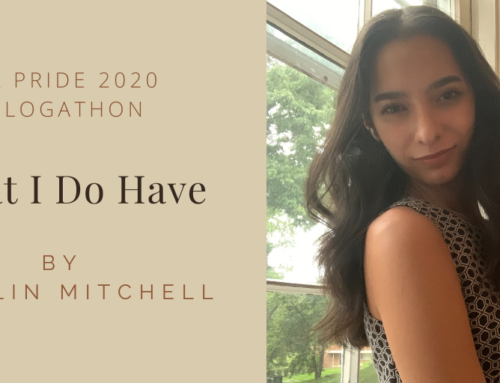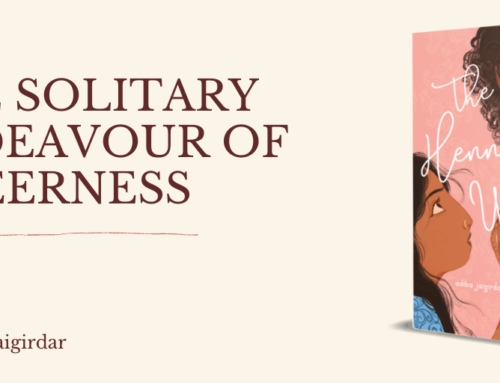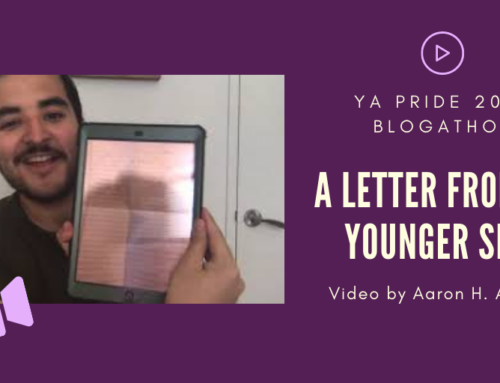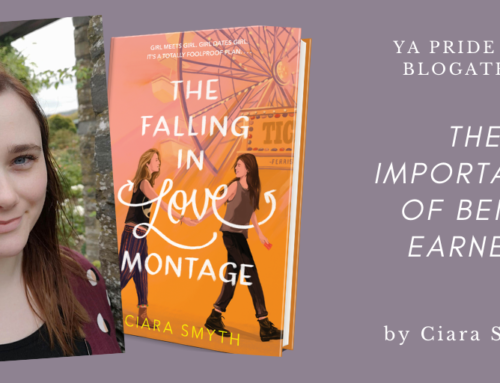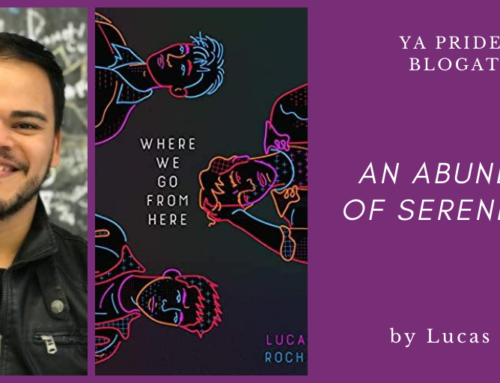Aromantic Spectrum Awareness Week Series: Day 4
by Natalie Ritter
(i)
While considering all the ways I could approach writing something worthwhile about how being aro and reading stories intersect, I was reminded of an instance in a speculative fiction creative writing class I took in undergrad. When it came to sci-fi and fantasy, it quickly became clear that, in this entirely white and mostly male class, there were “rules” that my classmates expected (and almost demanded) of sci-fi and fantasy stories. In a sense, there was a “contract” that these readers brought to this genre, and they were quick to react negatively to stories that did not meet those “rules.” These rules became the inflexible framework that they used to tell their story.
In one case, a fantasy story was presented to the workshop that had two main settings: a ship at sea, and a tavern in port. Naturally, all the crew members and everyone in the tavern were male (except for a smattering of tavern wenches). Unconsciously, this writer was creating a world where the default was male. I suggested to him that it would not be difficult to change a few pronouns from “him” to “her,” to casually mention in passing that some of the crew members were female, that some of the captains drinking together in the tavern were women. It would be a superficial change that would significantly alter the world that he had created: one where women serve on ships, women are captains, women do the work, and send a quiet message that this is standard and unremarkable. With a few find-and-replaces, he could do a hell of a lot to show gender equality in his fantasy world full of Dark Lords and wraiths and orcs and dire beasts.
He didn’t like my suggestion. Something about “that’s not how it would be” in a fantasy world. As we continued to workshop his story, it continued to sound tired, overly familiar. Yet another iteration of the familiar Chosen One rising to fight the Dark Lord.
(ii)
We’re quick to call out cliches, in my experience. We’ve been taught that once original expressions become overused, they lose their evocative power and start becoming irritating or simply unnoticed. For an author who wants to resonate with their readers, this is the last thing they want to happen to their words. When these clichés are phrases or sentences, they’re easy to spot, and easy to cull with some targeted line edits. But these overused expressions happen on larger scales, too, and they stop becoming cliches so much as simply being part of the “woodwork” of a story. Someone reading the story may enjoy it, but feel as if the story lacks substance without being able to name why. The background features of the story become tired, afflicted by “sameness.” Any genre that you pick up will have its own themes and variations that get passed through successive releases of new books, and YA is no exception.
For people who do not fall into the specific, usually recognizable modes of being that are found in the vast majority of the current English language book market (and particularly in YA), this becomes a double-edged sword: the reader becomes at odds with the underlying narrative, and is denied an opportunity to recognize and give name to the difference that they experience. This difference can occur, for example, when people identify as part of a spectrum that is given almost no credence by mainstream media: aromanticism. And it becomes very difficult for those on the aro spectrum to see how they might fit in these fictional worlds when so many authors choose the lowest-hanging fruit of narrative conflict, resolution, and change: romance. This over-reliance on an often unnecessary story element not only creates a sense of alienation in an aromantic reader, but also contributes to weaker stories being published in general.
For those of us who aren’t represented in our media, we know it’s a big deal. Having the ability to live vicariously through representation in fiction is important. Fiction presents a place to gain answers without the vulnerability of having to ask them. Fiction can answer questions, concerns, and fears we never knew we had. Fiction is a place to be known, where we learn that those thoughts, experiences, and reactions that we have are represented in the human spectrum of existence, that someone who came before us has already walked that path and left us some bread crumbs. Many of us don’t find aro representation until we are pretty deep in Goodreads booklists, hunting for the whiff of something that looks like us. Certainly it seems that YA books that omit a romantic story thread between main characters are vanishingly small.
And as we’ve likely discovered after more failed hunts than not, there are default cultural assumptions that get ingrained in our stories, and subsequently, in our expectations of future stories. The narrative default assumes that as readers, we’re straight, we’re white, able-bodied, at least middle class, cis, and we want to get married and have children. These assumptions become the scaffolding in our stories (the “woodwork” I mentioned earlier). When authors want to explore what happens when the princess marches off to meet the dragon, for instance, they may take the effort to develop a unique dragon culture. But then, they may fall back on their own cultural expectations about what a princess is and how she’s supposed to act and be treated, based on our historically based expectations of European women born into tenuous positions of power tied to marriage treaties and the Christian church. This is in spite of the fact that a fantasy princess in a world full of dragons could very reasonably have different expectations associated with her position, and might never hear the dreaded words of “proper” and “chastity” in her life.
An author’s real-world expectations become the unexamined assumptions that they bring to their story, and use as the framework, the scaffolding, of that story. When unchecked – just like privilege – this scaffolding is one vector of (not to put too fine a point on it) perpetuated sexism, racism, cultural superiority, and homophobia in our media. Very often, authors don’t intend this. They just don’t realize what they’ve written into the margins of their stories. For those of us who know how to spot those asides, they can be crushingly obvious.
These tropes and unexamined scaffolding of our stories do have utility. We know, for instance, that tropes like the “Empire” or “the Corporation” or “the Leader” are usually the bad guy – likely authoritarian, likely corrupt, and so on. It’s a quick way to cut straight to the guts of the story that the author wants to tell. But using these background tropes and scaffolding can often lead to a bland story, one that relies on the reader having the same expectations and background. So, where does that leave readers who don’t identify with this persistent narrative that finding love is a good and a right thing, that romance is something to long after? With the stories already published, we can recognize and name the issue. For the stories yet to be written, we can challenge authors to examine the stories that they tell.
(iii)
The problem with stories currently published is not that these stories contain romance, it is the expectation that stories are romance, that the pursuit of romantic love is a required part of the narrative. It’s easier to count movies and books without romance as a plot or subplot than it is to tally up the ones that do. It is indicative, I think, that I was so shocked and shyly pleased when major blockbuster Pacific Rim leaned more towards best bros between its lead characters and so neatly sidestepped the requisite onscreen kiss. To me, that was revolutionary.
The absence of that onscreen kiss, the ambiguity of what might be a deep friendship and nothing more, and how stark that absence of proof was: these all show the scaffolding we expected to find in that narrative. In this case, that romantic love is the conclusion. The conclusion of a story, of a life, of a character arc. The way in which romantic relationships play out can be a series of tropes (new kid on the block meets the girl next door, one of them is a fallen angel, and all of which is fantastic), but the presence of the romance is the unspoken expectation.
I’ve mentioned both “scaffolding” and “trope” so far. Scaffolding are the structures in our media that we don’t unpack and often don’t even see. In this particular case, “romantic love is the conclusion” supports and frames our stories so that the default becomes: happiness and fulfillment come when settled with a partner, or in pursuing romance and falling in love. On the other hand, tropes are often foregrounded, and tend to be used deliberately by an author. The parody Twitter account, @broodingYAhero, is an excellent example of the tropes that come out of these expectations.
To many people, finding that romantic connection with someone (and following the culturally approved steps of courtship headed towards appropriate milestones of meeting the parents and moving in, etc. etc.) is important. But to many stories, romance is beside the point. Irrelevant, even, to the narrative. This is why so many attempted romances often read as having no chemistry and as being “by-the-numbers.”
There are stories (such as the modern romance genre), where the relationship is the end goal of the story, and the events of the plot are designed to drive the story to that end goal. In other stories, the stakes of the story can be much higher. Our protagonists have to save the world, perhaps topple an authoritarian government. Romance is a usually a subplot, or the rewards for winning. Although these stories are attempting to achieve different things, the author is trying to make us react and respond to the story. We bring different expectations to different genres of stories, which also changes how much patience we have for various things. In other words, the presence of a romantic relationship in a romance novel would not cause a reader to blink an eye, whereas its presence in a dystopian story might feel unnecessary. What the romantic relationship has in common between both genres, however, is that the author is trying to hit some kind of emotional beats. The author is trying to convince us of something, and in a book that is not specifically focused on romance, the presence of a romantic plot may feel ham-fisted, trying to extract unearned emotional reactions from readers.
These romances often feel hollow and empty – at least in my readings. I’ve read romances that I’ve deeply rooted for, but have read significantly more that felt wooden and unnecessary. The nature of storytelling limits the dimensions of a life that can be portrayed, which leaves romance as the low-hanging fruit. It’s an easy chord to strike (or attempt to strike) as an author, an easy conflict to introduce to assist with character portrayal and motivation. Love and romance in fiction is often a writer’s shortcut, and this is often because it’s the easiest way to reduce the ensemble of characters and streamline motivation. If the character needs to make an important decision, let her feelings for her love interest factor significantly into that decision. Authors have to chose deliberately what to show and what to leave out.
Authors often write the stories that they read and loved when they were younger. This slowly, across generations of authors and readers, leads to stories that bleed out more and more around the edges, losing sharpness and detail, and retaining unexamined scaffolding. The stories become cliches as they’re written over and over again. When romantic love becomes a universal, convenient motivator, it becomes both unexamined and a silent expectation looming over us: it is a well that can always be drawn upon, even when there may be something else that would better suit a story.
But, aren’t writers supposed to write what they know? Aren’t they writing what makes them happy? Well, publishing is a complex ecosystem that is far larger than an author alone. But I suspect that most writers want to improve, to write better stories that touch their readers more deeply – stories that resonate with their readers in a way that affirms the author’s effort of putting the words to page. And for writers: I propose that taking a step back to really interrogate the scaffolding you use as a writer, to try and see how much is supported by your real-world environment, to subvert your tropes or exchange them for others, will allow you to write stronger stories that capture, engage, surprise, and please readers. Hopefully, this examination will also allow for more inclusive stories, stories that dismantle cultural assumptions, stories that teach us how to be more open to other modes of being. In light of events of late, this isn’t just a question about how increased aro representation can broaden the types of stories being told, but also that, for all these reasons, more types of stories with dismantled scaffolding must be told.
And that especially includes YA stories, which hit such a broad readership, which hit readers when they’re questioning and exploring. Once an author moves past default storylines that insist on teenage romance and/or love, other resonating story paths quickly open up. A consuming focus on another, a consummation of the self into others – these are things that the aromantic shies away from. We belong deeply to ourselves, but that does not mean we are without deep feelings for others, for institutions, for ideals. And those feelings make for powerful stories. So, I will leave this final thought, from the inestimable Ursula K. LeGuin: “No narrative of any complexity can be built on or reduced to a single element. Conflict is one kind of behavior. There are others, equally important in any human life, such as relating, finding, losing, bearing, discovering, parting, changing.”
—
Natalie Ritter is an aromantic reader of romance. She thinks it’s a fine genre, but has just written a long post about why she’s less than pleased when romance shows up in every genre. She sometimes hops into existence on Twitter under the handle @cited_by.
